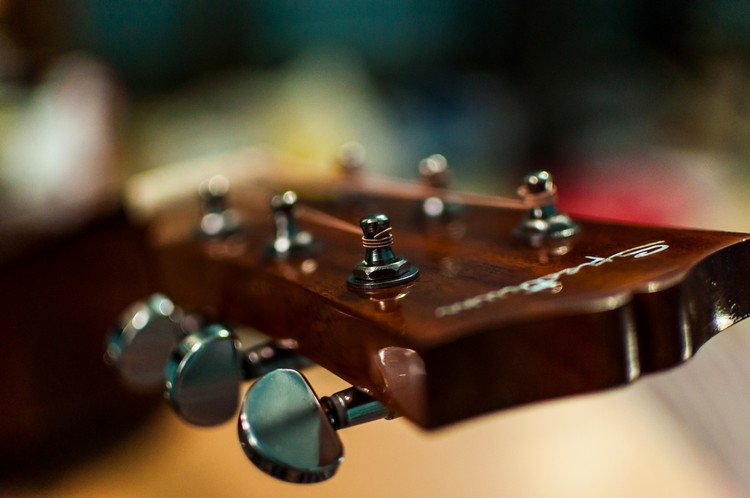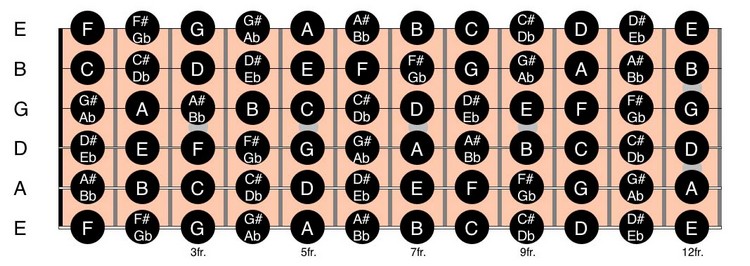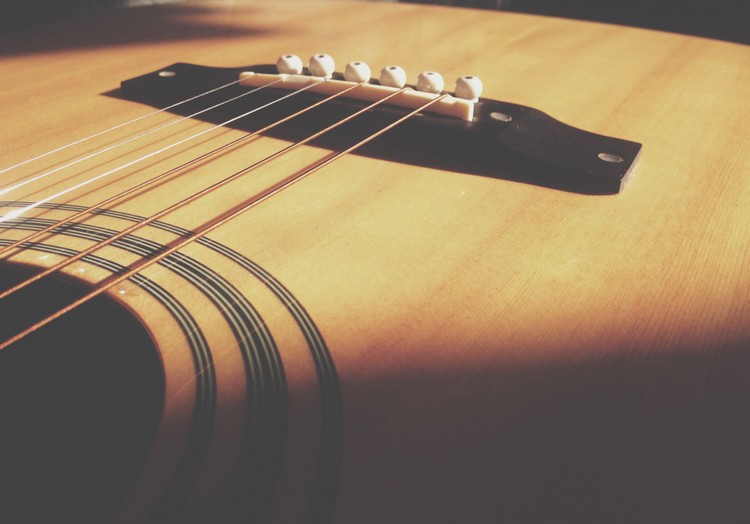The harmonic minor scale can open us up to all sorts of new sounds – let’s explore some harmonic minor scale guitar playing in this free lesson!
Over 100,000 guitar-learners get our world-class guitar tips & tutorials sent straight to their inbox: Click here to join them
In this free lesson you will learn…
- How the harmonic minor scale is constructed
- What it sounds like
- How to play it
- Chord construction
- Harmonic minor scale guitar riffs that you can use!
An Intro To Harmonic Minor Scale Guitar Playing
The harmonic minor scale is interesting and dynamic-sounding.
Often favoured in genres like heavy metal and jazz for its dark tones, harmonic minor scale guitar playing can help us add a darker element to our playing style, creating new moods that aren’t possible using just the minor scale.
Harmonic minor scale guitar playing can also be sprinkled into songs in a minor key by using the right chords (outlined below)
In this free lesson, we’re going to discuss what this scale sounds like, how we can construct it, as well as how to use it musically.
You can keep a distortion pedal nearby for this one if you like – now, let’s get heavy into the details.
What Is The Harmonic Minor Scale?
The harmonic minor scale is a seven-note scale that stems from the natural minor scale.
The interesting part about this scale is that it only takes one note to change the natural minor scale to a harmonic minor scale.
Pro Tip: The key is in the 7th note of the scale, and we’ll talk more about that below.
As you progress through this article, keep an ear out for the sound of that 7th note and how it changes the overall feel of the scale.
This is an important concept to keep in mind when learning any scale shapes for the first time.
What Does This Scale Sound Like?
The harmonic minor scale is dark, evil and sometimes even threatening.
This scale plays greatly on tension and resolution, and can help us create very melodically tense moments as we will see in the riffs section of this lesson.
Pro Tip: This may be one of the first scales where you will see note distances bigger than one whole step (2 frets).
The sound of harmonic minor scale guitar playing is characterized by the whole-half step (3 frets) within it.
In order to understand more about the sound of this scale, we need to understand the theory behind it and how it relates to the natural minor scale.
Let’s jump into that now!
Learn 12 EASY beginner chords with our popular guide

✅ Stop struggling. Start making music.
✅ Learn beginner-friendly versions of every chord.
This is our most popular guide and it will improve your chord ability quickly! 😎
Get your own personalised guitar-learning plan 🎸
Get a custom guitar-learning plan here: Click here for GuitarMetrics™
World-Class Guitar Courses 🌎
Learn from the world's best guitar educators: Click here for our guitar courses
Harmonic Minor Scale Guitar: Theory & Construction
As discussed above, the harmonic minor scale is made up of seven notes.
Although this is the same amount of notes as the natural minor scale, one note makes all the difference in the tone of this unique minor scale.
Let’s look at the intervals and steps of the natural and harmonic minor scales to help us understand the sound of harmonic minor scale guitar playing:
(W = Whole Step // H = Half Step // WH = Whole + Half Step)
Natural Minor Scale:
I II bIII IV V bVI bVII I
W H W W H W W
Harmonic Minor Scale:
I II bIII IV V bVI ♮VII I
W H W W H WH H
Did you spot the difference?
The ‘♮’ symbol that you see indicates a natural note.
- In the context of the natural minor scale, we are sharpening the bVII note so that it becomes a natural (♮) note.
- Due to this reason, we refer to the VII note in the harmonic minor scale as a Sharp 7, or Raised 7th instead of a natural 7.
- As you can see above, when we raise this 7th note we place it a half-step away from the root note.
Using this 7th note in our harmonic minor scale guitar playing can create tension, and moving up to the root note can resolve this tension.
It’s up to you how long you want to keep things creepy for!
Next, let’s take a look at the root position of harmonic minor scale guitar wizardry!
Harmonic Minor Scale Guitar: The Root Position
Before we continue – if you aren’t familiar with the minor scale and how to play it, check out this lesson on the D minor scale here.
For the purposes of this lesson, we’re going to play in the key of G harmonic minor.
The notes we need for this G harmonic minor scale guitar passage are:
G A Bb C D Eb F#
I II III IV V VI VII
Ready your fingers at the third fret, because this is where we’ll be spending most of our time today.
The riffs you will learn later in this lesson are also in the key of G harmonic minor to keep things consistent.
Your fingers should be positioned as follows:
3rd fret – Index
4th fret – Middle
5th fret – Ring
6th fret – Pinky
We can play this scale in the exact same way we would play the natural minor scale.
- When we reach the D string we will want to use our middle finger to hit the 4th fret (Sharp 7) before we return to the root note of G at the 5th fret.
- Harmonic minor scale guitar playing is tricky, especially in two octaves – That’s why we’ve illustrated one and two octave shapes of this scale for you here.
Be mindful of the step backward to the 2nd fret on the high E string!
Pro Tip: Take your time with these scale shapes, and be aware of the sharp 7 note at all times.
Memorizing the position of this note in every octave across the fretboard will help give you a landmark for your fingers, wherever you wind up.
Pro Tip: We say it often, but only because it matters – Sing the notes as you play them!
It might seem silly (or even intimidating) at first, but this is hands-down the best way to get the sound of new scales into your ears.
As we sing the notes while playing them, our ear registers these notes better than they would if we were solely playing them.
Now that we’ve got the shapes down, let’s look at the chords involved in harmonic minor scale guitar mastery!
Harmonic Minor Scale Guitar: Chords
The chords of any new scale are possibly the most important part to learn well.
“But what about the notes? That’s how we shred amazing solos!”
Correct! However, without the right chords underneath us, those amazing solos are just notes by themselves with nothing to support them.
Each note of this scale has a corresponding chord that matches and compliments it perfectly.
We can find the list of harmonic minor scale guitar chords below:
I – Minor
II – Diminished
bIII – Augmented
IV – Minor
V – Major
bVI – Major
bVII – Diminished
If you’re not familiar with some of these chords shapes, that’s okay! We’ve got them laid out for you clearly below.
Take some time now to familiarize yourself with these shapes below:
Pro Tip: The best way to master these chords is to play them out of sequence.
While you’re making your way through these chords, create mini-progressions that you can play to help you get a feel for how this scale pulls in a different direction than the natural minor scale.
- A great rule of thumb is to always learn chords first when starting on a new scale.
- Once we have the sound of the chords in our ears, we will have a better understanding of how the scale moves.
- On top of this, it will give our ear better direction for writing better solos using all of this harmonic minor scale guitar knowledge you now have.
Speaking of writing solos, let’s talk about how to use this scale!
Harmonic Minor Scale Guitar: How To Use It
Pro Tip: Finding out how a scale functions, and how it can be used is always one of the hardest parts of learning music.
With that in mind, we ask that you not get too discouraged in this section if you find that you just aren’t ‘getting it’ right away.
- Learning music takes time, commitment and patience.
- Give yourself the time and space you need to always learn effectively, and never rush your own learning process.
- The more time you put into practicing, the more mileage you’ll get out of your instrument long-term.
- This applies for all musicians, as well as any art form or craft in general.
With that, do you remember how we said that the raised 7th of the harmonic minor scale created tension?
We’re going to want to play on that. Due to the fact that the rest of this scale functions like a natural minor scale, we want to make use of the raised 7th to convey the sound of harmonic minor scale guitar playing.
Without this raised 7th, we are left with a simple natural minor scale – So start playing with tension! We’ve included the two-octave tab again below for reference.
Start out by playing over this jam track here.
- What we want to do for this exercise is play on the half-step distance between the F# (raised 7th) and the G (root note).
- As often as possible, play an F# to create tension, followed by a G to resolve it.
- This will help you get the sound of the scale in your ears. The more familiar your ears are with harmonic minor scale guitar playing, the easier it will be to manipulate it and create unique pieces of music.
Many different genres of music require this type of tension. Besides Rock and Metal, we can find instances of harmonic minor scale guitar playing in Funk music, Country, and even Pop music.
The dark element that the harmonic minor scale brings is versatile and unique, so experiment with the sound in different styles.
Pro Tip: Use the two octave scale above to create your own musical lines. After, have a look at the fretboard below to see what other places there are for you to play more G harmonic minor scale guitar!
Download our lead guitar cheat-sheet to make things easier
It's hard to understand which scales work with which keys.
So we created a cheat-sheet! A key and scale-finder that you can use again and again.

Get your personalised guitar-learning plan 🎸
Get a custom guitar-learning plan here: Click here for GuitarMetrics™
World-Class Guitar Courses 🌎
Learn from the world's best guitar educators: Click here for our guitar courses
Harmonic Minor Scale Guitar: Riffs You Can Use
We’ve written out three super-usable licks for you to bust out the next time you hear a harmonic minor scale guitar progression.
These licks function well over a variety of different chord progressions, making them handy to keep in your toolbox.
- This first example is a descending riff that starts on G at our high E string, 3rd fret. This phrase works great for when you want to move around the scale but resolve back to the root note quickly.
- You’re going to need all four fingers for this example, and they should be positioned in the same way that we play the scale.
Watch out for the step backward to the second fret, and move your other fingers back with the index. Remember to always be conscious of where your fingers are on the fretboard.
There is some brief one-fret movement to look out for in this one, but it’s nothing you can’t handle!
- Phrases like these are important because they help us speak in full sentences when we solo or improvise.
- It’s important to move your way around the scale when playing harmonic minor scale guitar, but it’s also important to know how to resolve back to the root note to ‘complete’ a phrase of music.
Our second example focuses on upward movement from the low E string to the D and back.
Once again we will find ourselves playing on the distance between the sharp 7 and the root note.
Use your index finger to slide back and forth from the 2nd to the 3rd fret where needed, and your pinky to reach the 6th fret.
Pro Tip: Play these riffs in different keys to experiment with the sound of them!
Our last example starts once again at the root note, but this time on the D string in the mid-section of the guitar.
- Each of these examples is designed to highlight one full interval of harmonic minor scale guitar playing.
- This helps us blend our knowledge of each string set together more easily.
Begin playing this section with your index finger on the D string at the fifth fret and position your fingers accordingly. This riff will challenge your ring and pinky finger, so take your time and be patient.
Pro Tip: You’re going to want to use alternate picking to get through these examples smoothly.
Alternate picking provides a smooth and consistent flow for our pick hand, and is an extremely useful skill to develop effectively.
Click here for a comprehensive guide to the alternate picking technique.
Where Do I Go From Here?
If you’re looking for more ways to master harmonic minor scale guitar playing, we recommend:
- Learn the chords of this scale inside and out to help you master this scale
- Once you have learned the chords, write a song!
- Write licks using your knowledge of harmonic minor scale guitar and play them over your song.
- Find more backing tracks on YouTube!
- Learn more about this scale with your guitar teacher
- Try jamming the chords of this scale with your friends!
Recommended Resources
If you loved this free lesson on harmonic minor scale guitar playing, you’re going to love some of the other free resources we have available for you! Check these out:
- Guitar Arpeggios – The Ultimate Guide
- Guitar Chords – The Ultimate Guide
- Intermediate Guitar Lessons – An Essential Guide
- Music Theory For Beginners – The 10 Step System For Rapid Progress
- Top 10 Guitar Books For Beginners
What Type of Guitarist Are You?
Take our 60-second quiz & get your results: Take The Quiz
Join the world's best online guitar school 🌎
- Get your own personalised guitar learning plan (customised just for YOU).
- World-class online guitar courses. Learn at your own pace.
- Community Campus & Learning Forum - A friendly community! Connect with our team & students. 😊
- Beginner Song library with chordsheets, tabs and tips. (Songs suitable for all levels!)
- Regular live streams, seminars and Q&A sessions - Learn from world-class guitar educators. Get all your questions answered!
Click here to learn more about National Guitar Academy membership 
Cool Guitar T-shirts 😎
Look cooler! Check out our merch: Click here to see our merch store
Want free guitar tips and video lessons delivered to your inbox?
Join over 100,000 guitar-learners and subscribe to our guitar-tips-by-email service. (It's free.)
We'll send you a series of lessons that will move you to the next level of your guitar journey.
Learn how everything fits together quickly, easily and effectively. We share ninja tips (for instant fun!) but also timeless fundamentals that will deepen your understanding.

Popular Lessons
How To Learn Guitar: An 11-Step Programme For Beginners
How To Choose The Perfect Beginner Guitar
More Cool Guitar Stuff
Learn about National Guitar Academy: About Us
Join us on Facebook for daily guitar tips.
Listen to our Learn Guitar Podcast for rapid guitar progress.
Check out our free chord lessons.
Get our best guitar tips & videos
Where should we send it?
Where should we send it?
Get our best guitar tips & videos




















